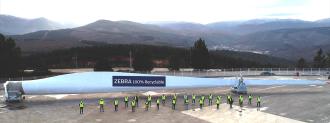Wind power is growing rapidly in the U.S., soaring from less than 1% of electricity generation in 2007 to nearly 8.5% in 2020 — a 10-fold increase.
But with this incredible growth has come a somewhat unwieldy problem: what to do with all of these wind turbine blades when they reach the end of their operational lives? The giant fan blades are cumbersome, large, strong as all get out, and made from non-biodegradable material.
The current answer is piling them up in landfills. With tens of thousands being progressively decommissioned, the piles are massive and accelerating. Casper, Wyoming, is already playing host to 850 of them, Bloomberg reported.
Wind power is growing, and with it a problem: what to do with wind turbine blades at the end of their lives?
“The wind turbine blade will be there, ultimately, forever,” Bob Cappadona, of French firm Veolia Environnement S.A., told Bloomberg.
“Most landfills are considered a dry tomb. The last thing we want to do is create even more environmental challenges.”
The French research center IRT Jules Verne is looking to create a sustainable wind turbine blade, launching the ZEBRA project in 2020. The project, which stands for “Zero wastE Blade ReseArch,” is a collaboration with companies like Danish wind turbine blade manufacturer and GE subsidiary LM Wind Power and fiberglass juggernaut Owens Corning.
ZEBRA has recently hit its first milestone, unveiling the first prototype of a fully recyclable wind turbine blade, made from thermoplastic resin and high performance glass.
“The manufacture of this first blade is a great success for the entire consortium and for the wind industry in general,” IRT Jules Verne project manager Céline Largeau said in a statement.
Tilting at wind blades: A wind turbine blade is a massive structure, in typical cases over 100 feet long. The largest towers in the world can sport blades over 350 feet.
The material they’re made of presents a challenge, as well: blades are typically made from fiberglass, which, due to its high strength and low weight, is ideal for the job. But fiberglass is also non-biodegradable, and that strength cuts both ways — it’s really tough to recycle.
ZEBRA’s prototype wind turbine blade takes this challenge head on, by redesigning the blades from the outset to consider their whole lifecycle: construction, use, and disposal.
As the blades turn: By utilizing thermoplastic resin (designed by ZEBRA member Arkema) and Corning’s high performance glass material, ZEBRA has created a 203-foot prototype blade capable of being broken down into its composite parts, fully reduced for repurposing.
ZEBRA’s next step will be testing their blade design in LM Wind Power’s proving ground to verify the material’s performance and feasibility, industry publication Offshore WIND reported.
”With this project we are addressing two crucial industry challenges,” John Korsgaard, senior director of engineering excellence at LM Wind Power, said.
The first involves creating the blades themselves; ZEBRA believe their recyclable wind turbine blade design will cut down on the waste associated with decommissioned blades. And the material made from the broken-down blades could possibly be used for other applications.
A circular economy, if you will.
We’d love to hear from you! If you have a comment about this article or if you have a tip for a future Freethink story, please email us at [email protected].






